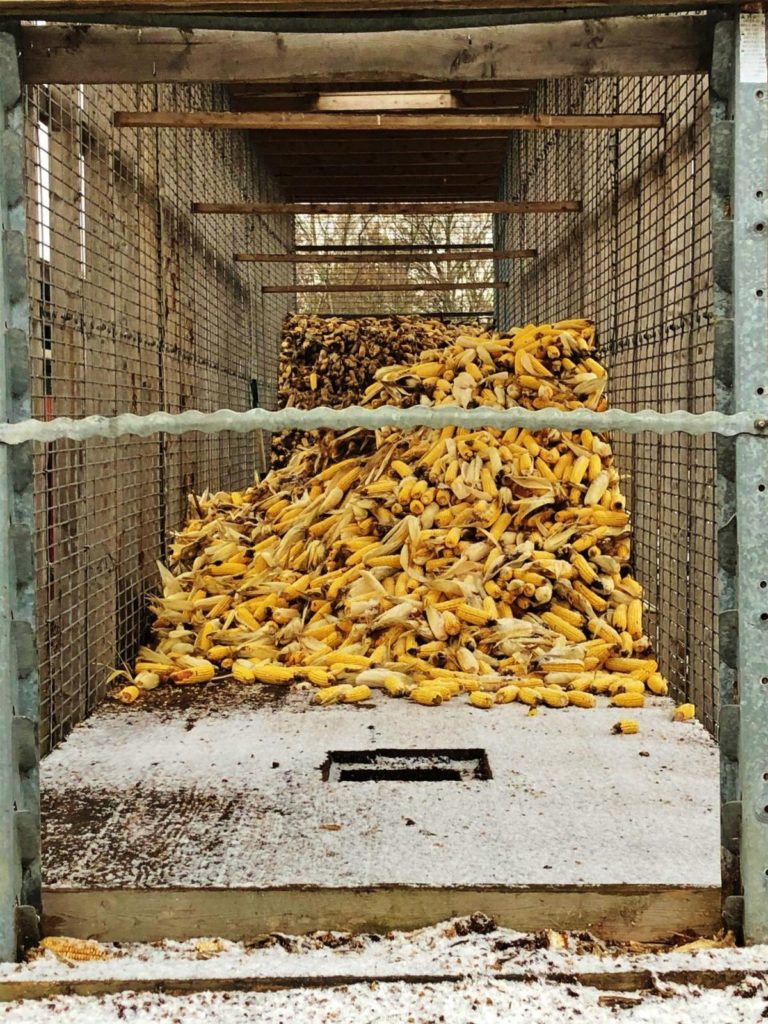Back Home by Chris Hardie
» Download this column as a Word document
» Download photos that accompany this story
» Chris Hardie’s headshot
It’s harvest season; large combines are making short work of picking, husking and shelling millions of acres of this year’s corn crop. That shelled corn is stored in large concrete elevators and steel grain bins throughout farm country.
But before combines arrived in the 1950s most of the crop was stored as cob corn in a corn crib. A crib has slats in the walls allowing air to circulate and dry the corn so it won’t mold.
Take a trip through the countryside — especially where smaller farms once thrived — and it won’t take long to spot a corn crib. They come in all shapes and sizes. Some are double corn cribs joined by a large roof with storage space between. Others are free-standing. Some are circular structures with the sides enclosed in wire mesh; sometimes snow fence was used.

Our farm had a wooden corn crib that was long and narrow, built upon sandstone rocks used as footings. One of my earliest chores as a youngster was feeding the chickens. That involved filling a pail with ears to take into the nearby chicken coop. Sometimes I would just throw the cobs on the floor. Other times I would shell the cobs by hand until my thumb would start to blister.
Before my time, corn was processed by a corn sheller located next to the grain bins in the barn’s upper loft. The sheller was powered by a belt that ran off an old Ford tractor. The corn was used to feed the cows. We also had an antique hand-cranked corn sheller that was used for smaller jobs.
The corn crib was no longer used after a silo was built in 1975. We at one time would grind the entire corn cob and blow it into the silo, where it became high-moisture feed. There was no reason to store corn cobs anymore, so the corn crib was torn down.
The key to storing any corn is in kernel moisture, ranging from as much as 35% for corn silage to 20% for picking cobs. The cribs are designed to allow air to flow around the cobs, continuing the drying without mold.
The wet and cool spring that delayed corn planting this year along with recent winter weather has left many cornfields with greater moisture content. Combining corn that is too wet requires additional mechanical drying, which adds an additional cost.
An even-more-ancient form of corn harvesting is still used by some smaller farmers. Corn shocks — where stalks of corn are tied together to be stood upright in the field — are then fed to livestock.
Corn cribs are still used by some farmers. A neighbor of mine — Edwin Borntreger — recently built a new corn crib. The crib is long and narrow, enclosed by a roof and with wire-mesh sides. The innovative part of the corn crib is the elevator that runs underneath. Corn can be pushed through several holes in the floor. It’s then carried by the elevator to one end of the crib where it can be dropped into another elevator for loading.
I’ve also seen corn cribs used for storing firewood — a great way to keep rain off the wood while still exposing it to air for drying. My great-uncle Vilas Steine would at one time fill his corn crib with wood every year — which he did well into his 80s.
But for the most part corn cribs are going the way of silos, disappearing from the rural landscape. They are reminders of a bygone era.
Chris Hardie spent more than 30 years as a reporter, editor



